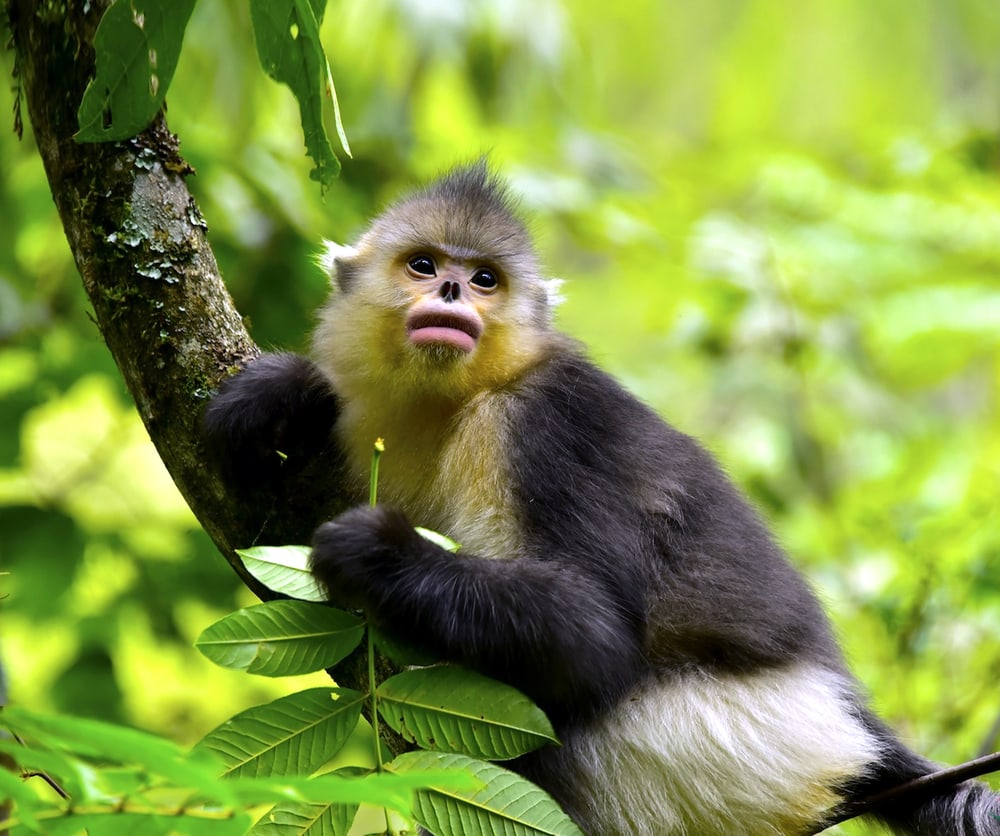Outforia Quicktake: Key Takeaways
- The black snub-nosed monkey is an endangered primate found in high-altitude forests in China, adapting to harsh environments with a wooly fur coat and specialized diet of mainly lichens.
- Poaching and habitat destruction have threatened the population, resulting in their endangered status.
- Conservation efforts, such as protective laws and the Biodiversity Strategy and Action Plan for Yunnan Province, have been implemented to preserve the species and its habitat.
- The black snub-nosed monkeys are social creatures with unique group dynamics, living in units within large troops.
- The species is primarily arboreal, living in coniferous, deciduous broadleaf, and mixed coniferous forests within the Three Parallel Rivers of Yunnan Protected Areas.
The black snub-nosed monkey (Rhinopithecus bieti) is an endangered primate restricted to the forested mountains of the Yunnan Province and border of southwest China.
They’re also referred to as Yunnan snub-nosed monkeys. Unlike any other monkeys, this species survives in extreme high-altitude environments.
French mammalogist Alphonse Milne-Edwards studied primates in the snub-nosed monkey range in the 19th century. Years after identifying the Myanmar snub-nosed species, Milne-Edwards identified the black snub-nosed species.
Among primates, snub-nosed monkeys are considered some of the most endangered in the world.
You May Also Like: What Do Monkeys Eat? Definitely Not What You Expected!
Classification
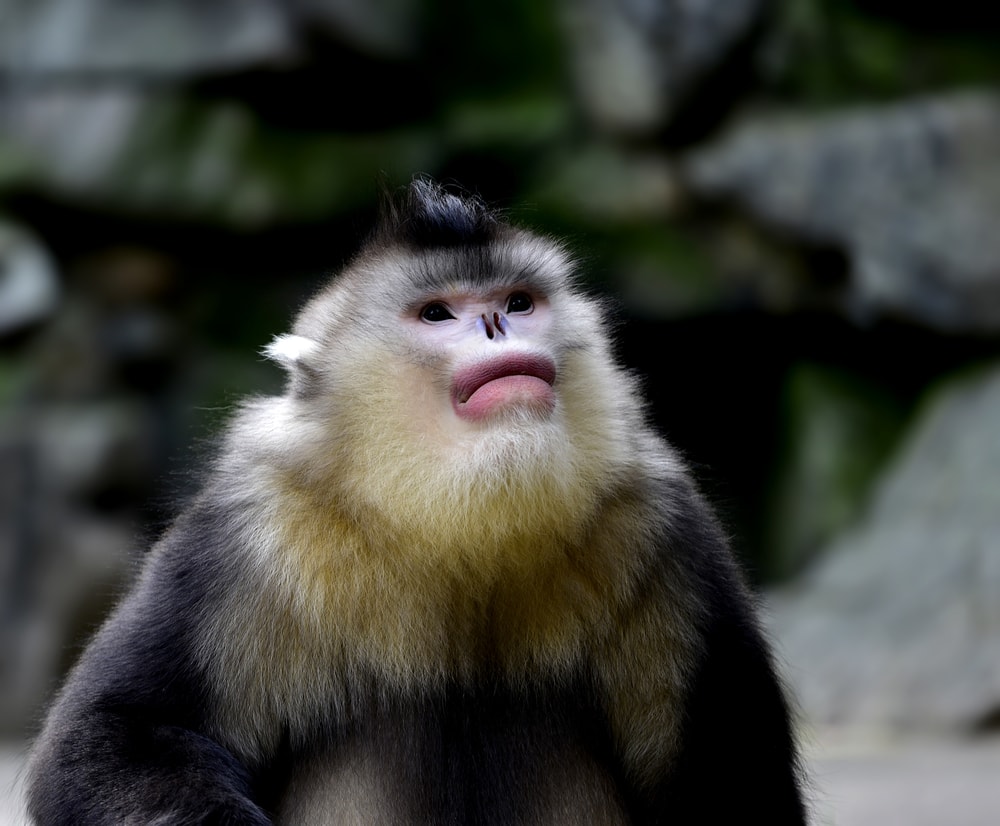
Black snub-nosed monkeys are in the Cercopithecidae family. This includes Old World monkeys.
The family consists of more than 120 species, including baboons, macaques, and langur primates.
Snub-nosed monkeys belong to the Colobinae subfamily of Old World monkeys. This subfamily also includes proboscis and pig-tailed langurs. Colobinae primates are native to African and Asian forests.
There are five main snub-nosed monkey species, which include:
- Black snub-nosed monkey (Rhinopithecus bieti)
- Gray snub-nosed monkey (Rhinopithecus brelichi)
- Golden snub-nosed monkey (Rhinopithecus roxellana)
- Myanmar snub-nosed monkey (Rhinopithecus strykeri)
- Tonkin snub-nosed monkey (Rhinopithecus avunculus)
Snub-nosed monkeys are considered rare. All species are either endangered or critically endangered according to the International Union for Conservation of Nature (IUCN).
Geographic Location and Distribution
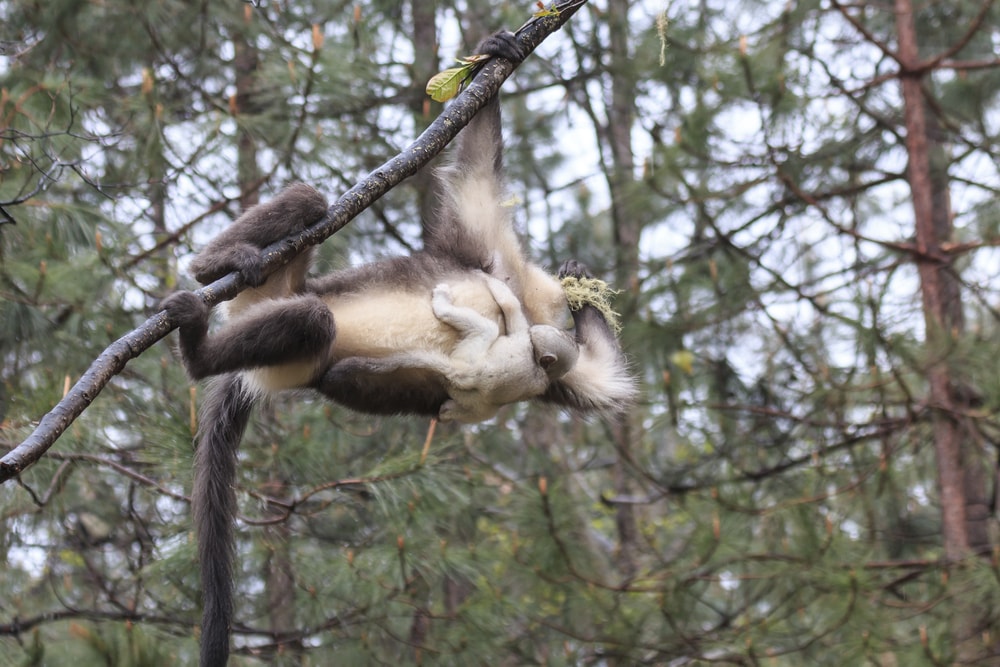
Black snub-nosed monkeys are restricted to the Chinese province of Yunnan and the border of southwest China and the Tibet Autonomous Region. Fragmented populations occur in the Yun Ling mountains between the Yangtze and Mekong rivers.
Although subject to deforestation in unprotected areas, this area of China is underdeveloped. However, increased human activity puts the species at risk of critical endangerment.
The black snub-nosed monkey range is limited to about 9,600 square miles. They live in the forests of the high mountain tops.
Black snub-nosed monkeys are one of the only primates to live at such high altitudes. Their lifestyle and diet allows them to survive at altitudes between 9,800-14,700 ft (2,987-4,481 m).
Below freezing temperatures that last for several months out of the year are unfavorable conditions for most primates. Yet, black-snub nosed monkeys are able to withstand these harsh conditions.
Black Snub-Nosed Monkey Habitat
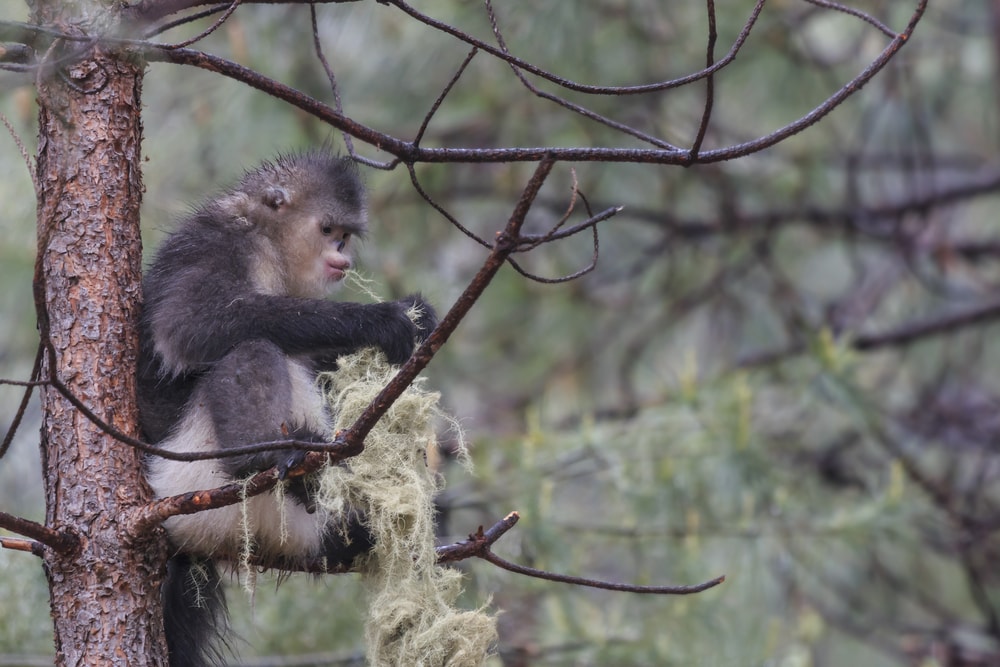
Black snub-nosed monkeys live in coniferous, deciduous broadleaf, and mixed coniferous forests. Their habitat is located within the Three Parallel Rivers of Yunnan Protected Areas. This area requires protection as it’s listed on the United Nations World Heritage List.
The black snub-nosed monkey is primarily arboreal. They may travel on the forest floor between feeding and resting sites. However, most of their time is spent eating and sleeping up in the trees.
During the rainy season, their habitat is filled with more food varieties. Rainfall is most abundant between June and August. This is the small portion out of the year when the ground isn’t frozen.
Temperatures drop drastically in the late fall, and the ground remains frozen for more than half the year.
Frequent snowfall often results in multiple feet of snow covering the ground from November to April. Despite these conditions, black snub-nosed monkeys have a special diet and wooly fur coat to help them survive.
Unique Appearance of Black Snub-nosed Monkeys
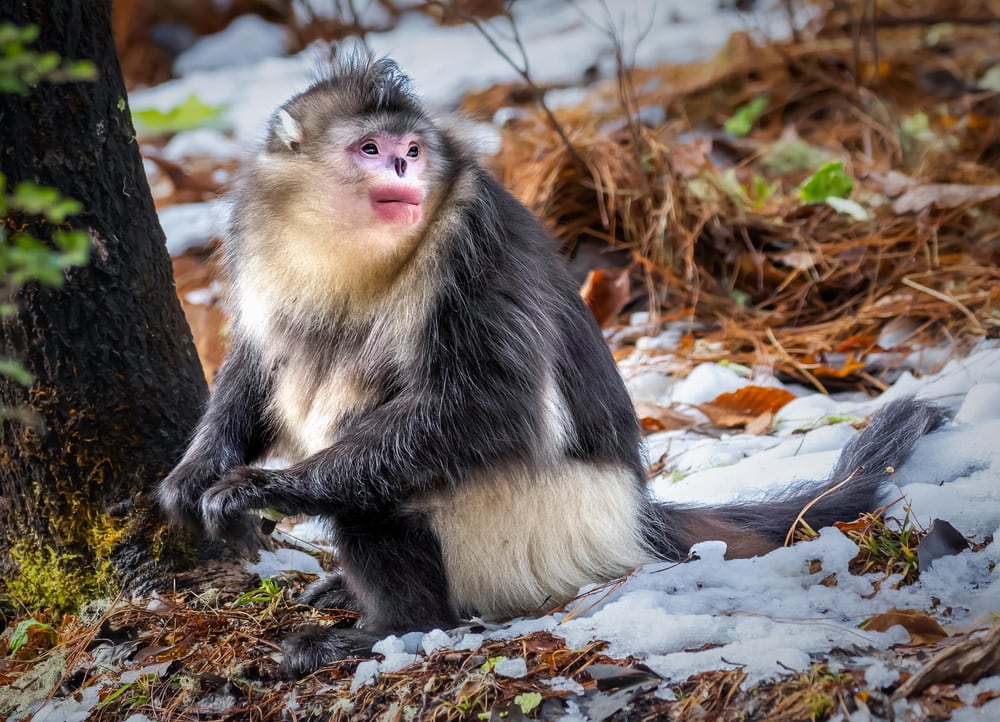
Black snub-nosed monkeys have a black, white, and gray wooly coat of fur. The arms, legs, head, tail, and body are covered.
The arms are covered in black fur, which may gradually turn gray near the shoulders. Their back legs have black to gray fur. White to cream-colored fur surrounds their bare face and covers the belly, rump, and chest.
Black snub-nosed monkeys range between 20-32 inches (51-81 cm) in length from the head to the base of the tail. They have long tails that usually measure the same length of their body.
Males are much larger than females. An adult male weighs around 30 pounds, while females weigh only 20 pounds (9 kg).
One of the most distinct features of the black snub-nosed monkey is their big lips and lack of nasal bones. Their nose openings appear black, which has somewhat of a skeletal look to it. Their prominent lips are usually light pink while the eyes are small and almond-shaped.
Baby black snub-nosed monkeys are born fully white or a light cream color. Darker fur colors emerge as they become adults.
Behaviors and Group Dynamics
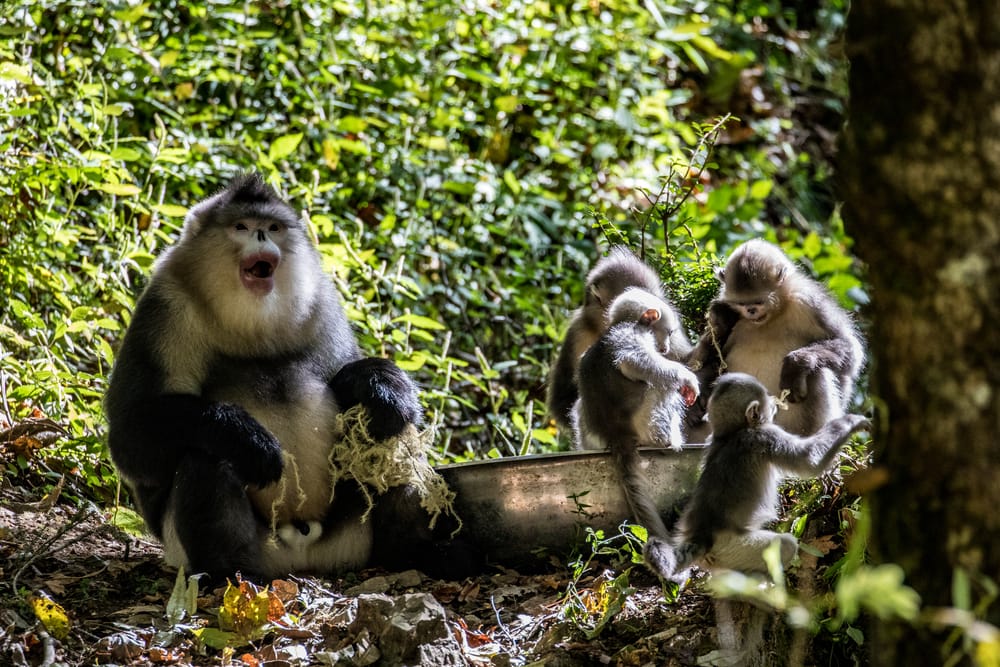
Black snub-nosed monkeys are social creatures that live in units. Multiple units can occur in one large troop.
A troop can consist of as little as 20 individuals. Large troops can have more than 300 individuals. There can be anywhere between 11-26 units within one troop.
One dominant adult male exists in every unit. The other members are females and juveniles. These units are called one male units (OMUs). On rare occasions, there may be two adult males within one unit with multiple females. This is referred to as a multi-male unit.
Although members within one unit get along, these units don’t typically mix together. They actually keep their distance from each other.
Even though they’re a part of one troop, units keep a distance to prevent dominant male friction. Non-dominant males may form an all-male unit (AMU).
Mothers and babies are considered the most vulnerable. Therefore, they receive the most protection.
Black snub-nosed monkeys settle in for the night up in a tree. Mothers and babies always enter the tree first. Other females follow after, and then the dominant male.
The unit huddles together in a tree with the mother and baby in the center. Huddling helps keep these monkeys warm in the harsh below freezing temperatures. Tree resting sites are specially selected for protection from the wind with access to the sun to maintain warmth.
You May Also Like: How Long Do Monkeys Live? From Old World To New World
What Do Black Snub-nosed Monkeys Eat?
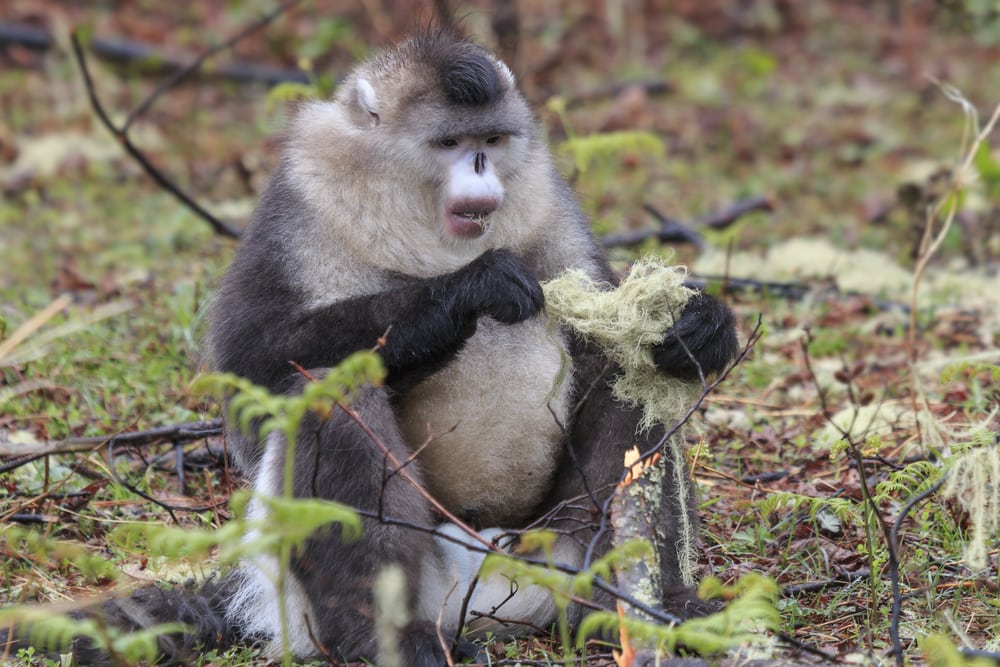
The snow-covered forest floors of the black snub-nosed monkey range provides a limited menu of food for these primates. But black snub-nosed monkeys depend on a special moss-like organism called lichen.
Lichen is typically one of the only food sources available during the harsh winter season. Some lichen species are toxic. But black snub-nosed monkeys are to digest the toxins in this organism. They have special stomachs that can digest it without issues other animals that feed on them may have.
Although lichens are the primary diet of black snub-nosed monkeys, they also feed on other plant matter when available.
They favor leaves off of coniferous and broadleaf trees. Spring and summer hosts the most abundant food sources.
Black snub-nosed monkeys can feed on various types of fruits, berries, grasses, nuts, and seeds during the spring. They occasionally enjoy eating insects and the toxic nectar of the rhododendron flower.
Black snub-nosed monkeys stay hydrated by drinking water from temporary water pools or ponds and streams. Snow may be consumed during the winter if water sources are scarce.
Conservation Status
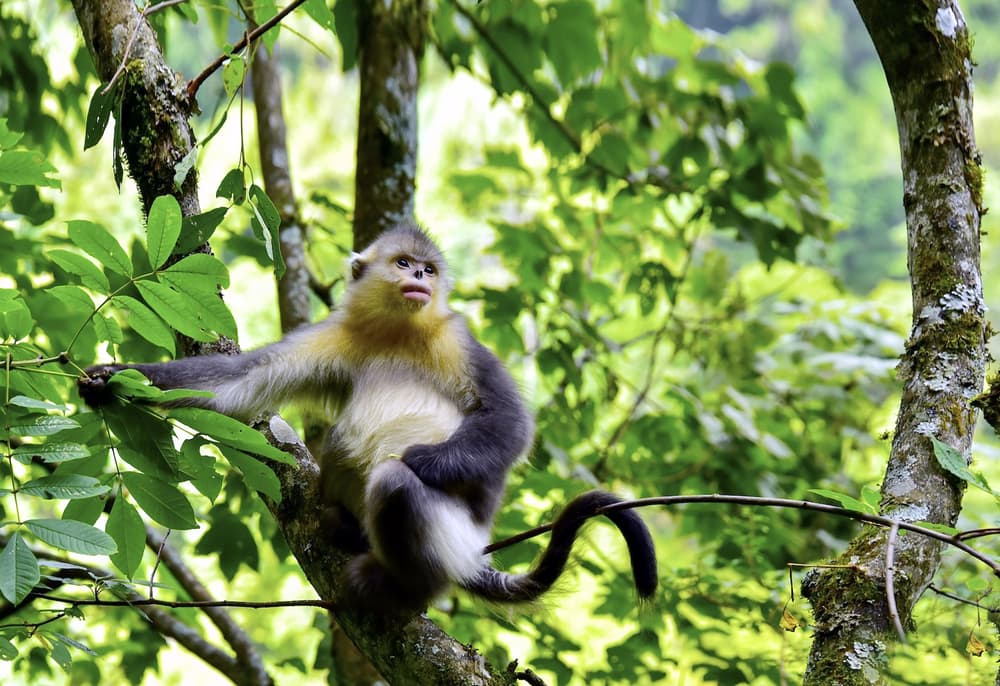
The black snub-nosed monkey is classified as an endangered species. Their population status was last assessed in March 2015 by the IUCN. At that time, only 1,000 mature individuals were estimated to exist in the wild.
Conservation programs put into place following the assessment may have helped the population increase.
The Tibet Autonomous Region population was as low as 50 individuals in the 1990s. The overall population of this primate suffered from poaching in the early 1990s.
Conservation efforts and established protected lands have helped the population increase and become more stable over the years. By 2013, the population grew to 700 individuals in the Tibet range.
A distribution records report published in 2019 stated that there were 15 groups of Yunnan snub-nosed monkeys. These groups were split up into 5 different units based on various factors.
Black snub-nosed monkeys, along with three other snub-nosed species, were classified as endangered on October 29, 1990. The Federal Registrar, on behalf of the U.S. Fish and Wildlife Service, described them as the “most critically endangered primates in the world”.
Poaching and habitat destruction are major threats to the snub-nosed primate populations. Their range has been reduced significantly due to deforestation and other human activities.
The slow reproductive process of these primates makes it difficult for the populations to increase.
Protecting the Black Snub-nosed Monkey Population
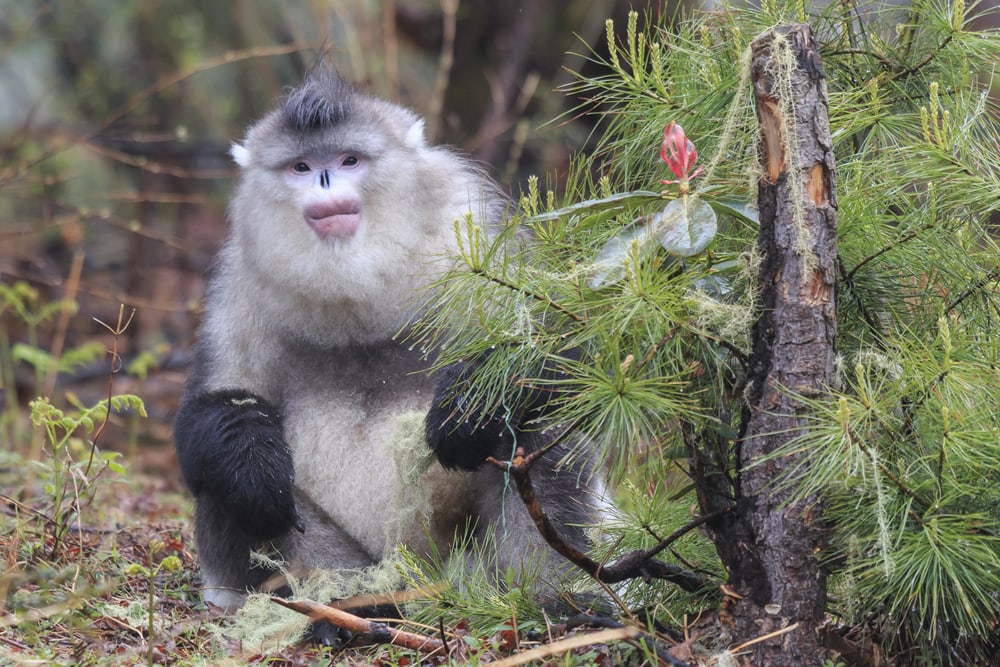
The Law of the People’s Republic of China on the Protection of Wildlife defines protective measures for wildlife and wildlife resources of rare or near extinction species.
The Wildlife Protection Law was first adopted in 1988. Since then, major revisions have granted protective services to more species. Black snub-nosed monkeys are considered a protected species in China.
Further conservation efforts have been put into place since the approval of the Biodiversity Strategy and Action Plan for Yunnan Province in 2013. The provincial action plan is designed to help preserve the rich biodiversity of the Yunnan region.
If continuous progress is made toward protecting black snub-nosed monkeys and the biodiversity of the Yunnan forests, we can hopefully see a bigger increase in population.
You May Also Like: The 7 Smallest Monkeys In The World: Pictures + Facts
Black Snub-Nosed Monkey FAQs
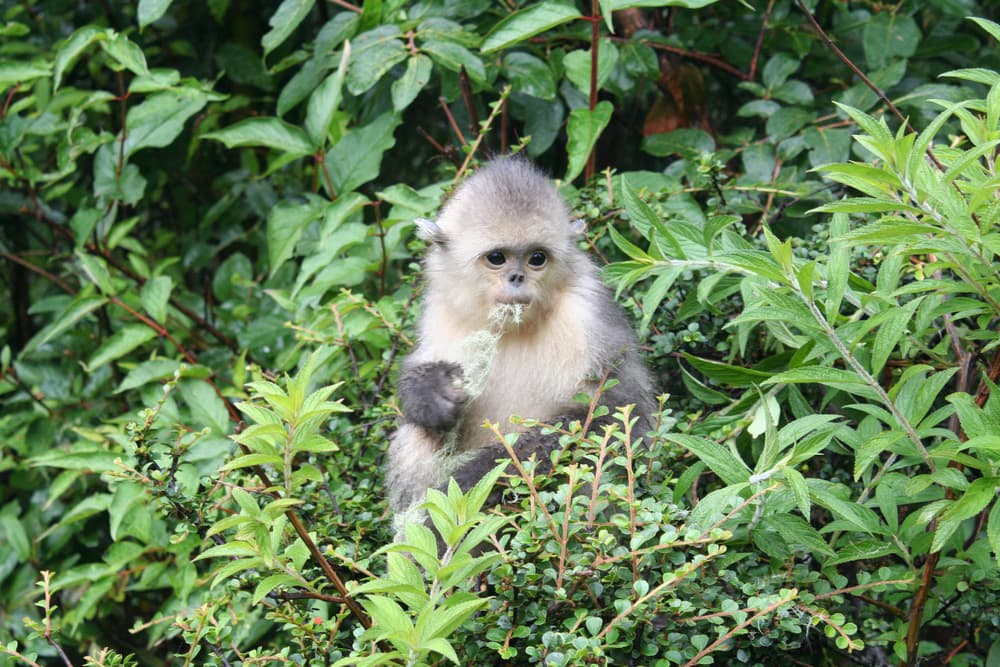
What is the most endangered primate in the world?
The most critically endangered primate is the Hainan gibbon ape. They were listed as one of the top 25 most endangered primates in 2017. Their range is limited to a small area in the southwest portion of Hainan Island, China.
The population was originally assessed by the IUCN at 15-20 individuals in 2008. The last IUCN assessment in 2015 estimated the population to be 10 individuals.
What are lichens?
Lichens are a special type of organism that look like a fungi, but aren’t classified as such. They’re actually fungi and algae combined. These two organisms have a symbiotic relationship that results in the creation of lichen.
There are at least 18,000 different lichen species known. About 3,600 of these species can be found in North America. A number of lichen species are poisonous.
It’s not a common food source for most primates, but black snub-nosed monkeys depend on it.
How long does it take black snub-nosed monkeys to reproduce?
The reproduction process for black snub-nosed monkeys is pretty slow. Taking care of babies until they’re weaned is hard work.
Adults reach sexual maturity at 4-6 years of age. Female black snub-nosed monkeys mate and give birth every 2-3 years.
After giving birth, mothers spend all their energy caring for their young. Baby snub-nosed monkeys must be protected at all times because they’re so delicate and vulnerable.




